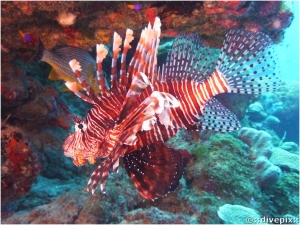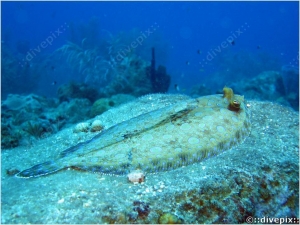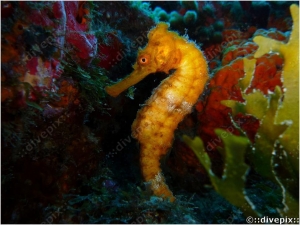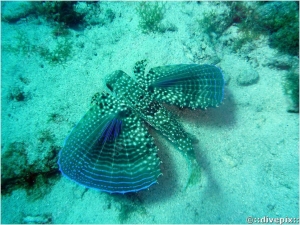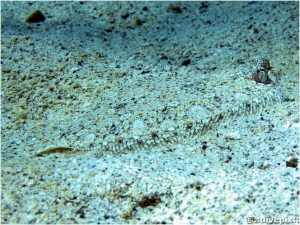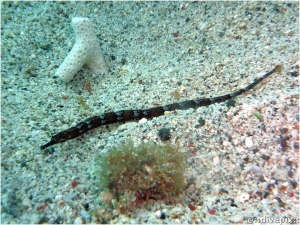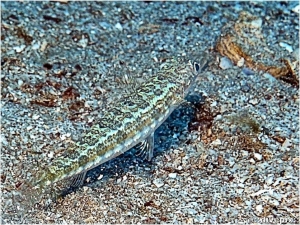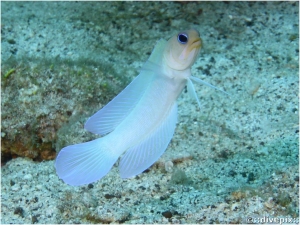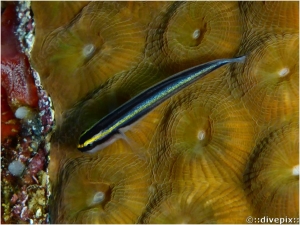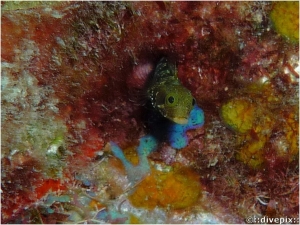




Eric H. Biass
Sunday, 09 December 2012 12:34
Red Lionfish
| Aspect: | From dark maroon through red to light brown (depending on sexual activity) with irregular white vertical bars. All fins are mottled white/body colour and look like wing feathers (hence volitans, or flying in Latin). Reproduction is phenomenal: a female spawns some 15,000 eggs that are immediately fertilised by the male, with larvae hatching after only 36 hours to become capable swimmers days later. Has very few predators. |
| Population: | Originally an Asian area species and unknown to the mid- and south-Caribbean sea until 2010 when it started to spread like a plague following, it is alledged, the rupture of a Florida aquarium caused by Hurricane Andrew in 1992. Rare in 2010 around Ilets Pigeon, ubiquitous two years later. |
| Notable feature: | Dorsal, anal and pelvic spines are venomous. Close-up pictures taken here show that there is no real element to substantiate claims of diiferent species to minimise the responsibility of the Miami aquarium debacle. Eyebrow growth, colour differences and number of poisonous dorsal fins (photos shown here reveal between eleven and twelve) appear to pertain to age and stress. |
| Environment: | Anywhere day and night (though it hunts at night) around the reef, up to five or six can be found at a time under a rock overhang. |
| Behaviour: | Can be approached, with usual precautions, but has a habit of turning round to show its back, probably to present its very harmful (can eventually cause gangrene) dorsal and pelvic spines. Although the latin word volitans means "flying" or "hovering" to reflect the animal's wing-like fins the Pterois Volitans does not fly, contrary to what the French designation Rascasse Volante may suggest. |
Published in
Lionfishes
Tagged under
Saturday, 08 December 2012 20:36
Peacock Flounder
| Aspect: | Like smaller Eyed Flounder a master of deception, but sports blue main tones instead of tan. Top of tan body covered in blue rimmed peacock-like roundels and carries two large dark blotches along its centre line. Edges (fins) sport bluer tones. |
| Population: | Abundant. |
| Notable feature: | Eye turrets somewhat less conspicuous than Eye Flounder's, can also semi-bury into the sand. However, as the red-framed pictures below show, this is the same fish in the same spot changing attire in a fraction of a second! |
| Environment: | Hides under the sand. Spotting it requires a trained eye. |
| Behaviour: | Must be approached very cautiously. |
Published in
Flounders
Tagged under
Saturday, 08 December 2012 18:43
Longsnout seahorse
| Aspect: | Generally yellow or orange, but can turn black depending on surroundings |
|
| Population: | Rare sight, spotting requires a trained eye. |
|
| Notable feature: | Distinctive "S"-shaped body, the tail end of which curls around a mooring structure (coral, or as is more usually the case, a rope sponge. |
|
| Environment: |
Quiet waters, close to a sandy seabed or sheltering rock crevices |
|
| Behaviour: |
A defenceless creature that has to be approached cautiously and very respectfully, or it will change quarters, never to be seen again. |
Published in
Seahorses
Tagged under
Saturday, 08 December 2012 18:22
Fying Gurnard
| Aspect: |
Brownish with white dots. May at first sight be taken for a lizardfish (similar size), but long backswept pectoral fins reveal a different fish altogether, with a stub head and prominent eyes. |
|
| Population: | A rare sight in the immediate vicinity ot Ilets Pigeon, but is quite commonly spotted closer to the Malendure beach. |
|
| Notable feature: | Turns stones over with its pelvic fins in search of food. Unexpected large and colorful pectoral fins, when deployed. Zebra-spined translucid tail fin structure reminiscent of that of Lionfish, unsurprisingly as both are scorpaeniforms. |
|
| Environment: | Quiet shallow waters (10 metres maximum), sandy seabottom, quiet ware. |
|
| Behaviour: |
Can be approached quite closely, but will eventually take a short leap, deploying superb fan-like pectoral fins. Although the latin word volitans means "flying" or "hovering" to reflect the animal's wing-like pectoral fins the Flying Gurnard does not fly. |
Published in
Searobins
Tagged under
Saturday, 08 December 2012 17:33
Eyed Flounder
| Aspect: | Like larger Peacock Flounder a master of deception, but sports brown/tan main tones instead of blue. Top of body covered in mosaic-like roundels, or "eyes". |
| Population: | Abundant. |
| Notable feature: | Leopard-skinned rear of protruding eye turrets distinguishes it from Peocock Flounder when dug into the sand. |
| Environment: | Hides under the sand. Spotting it requires a trained eye. |
| Behaviour: | Must be approached very cautiously. |
Published in
Flounders
Tagged under
Saturday, 08 December 2012 17:18
Diamond pipefish
| Aspect: | Pipefished like this one actually looks like a small "straightened" seahorse, a feeling confirmed by the shape of it head. |
| Population: | A very rare sight, enhanced by the fact that it hides under stones on a soft, coral sand seabed. The sample seen here, for example, was photographed on a swimming path followed by dozens of divers per day. Oddly enough, quite common in France's south seaside marsh pond, Etang de Thau. |
| Notable feature: | It owes its name to the white-ish diamonds that adorn its black on either side of the sine line. Another characteristic feature is the array of refular transverse rings running throughout the length of the body. |
| Environment: | Rarity on Ilets Pigeon precludes a typical habitat, but this easy prey is said to affectionate sandy seabeds close to rocks under which it can hide away from predators. |
| Behaviour: | A very slow swimmer. |
Published in
Pipefishes
Tagged under
Saturday, 08 December 2012 16:48
Bluestriped Lizardfish
| Aspect: | Complex dorsal pattern reminiscent of a Persian silk carpet with a distinctive, uninterrupted blue side line runs from upper gill area to tail. |
| Population: | Rare. |
| Notable feature: | Above-mentioned blue line actually distinguishes it from twice larger and more common Sand Diver (q.v.). |
| Environment: | Sandy bottom in which it buries itself, awaiting for a prey to pass by. |
| Behaviour: | Can be approached, very slowly. |
Published in
Lizardfishes
Tagged under
Saturday, 08 December 2012 12:19
Yellowhead Jawfish
| Aspect: | Pearlised white body that mostly reflects surrounding colours, with delicate wavy scale patern, and yellow head. Dorsal fin runs from head to tail. |
| Population: | Very common. |
| Notable feature: | Prominent forward-set globular eyes. |
| Environment: | Typically hovers semi-vertically over its burrow in sandy botton at depths of 20 to 40 metres. |
| Behaviour: | Remains quiet in a hovering position, but abruptly sinks backwards into its hole if approached too closely. |
Published in
Jawfishes
Tagged under
Saturday, 08 December 2012 11:50
Sharknose Goby
| Aspect: | Black upper streamlined body, pale belly |
| Population: | Common. |
| Notable feature: | Deep bright yellow V on snout crosses upper part of prominent globular eyes fading directly into a blue washout on sides of body. Cleaning Goby (q.v.) instead sees the yellow fade into a grey whashout. |
| Environment: | Often seen resting on Boulder Star (q.v) coral boulders. |
| Behaviour: | Unaffected by divers. |
Published in
Gobies
Tagged under
Friday, 07 December 2012 16:54
Secretary Blenny
| Aspect: | Generally a green body and head with more or less visible cirri above the eyes . Large squarish mouth |
| Population: | Common. |
| Notable feature: | Prominent globular eyes with either lighter green or yellow surround. |
| Environment: | Any tiny hole in a rock or coral boulder, but also an uninhabited barnacle, may provide a useful home. |
| Behaviour: | Generally only shows its head, but will retreat completely if approached too briskly. |
Published in
Blennies
Tagged under



